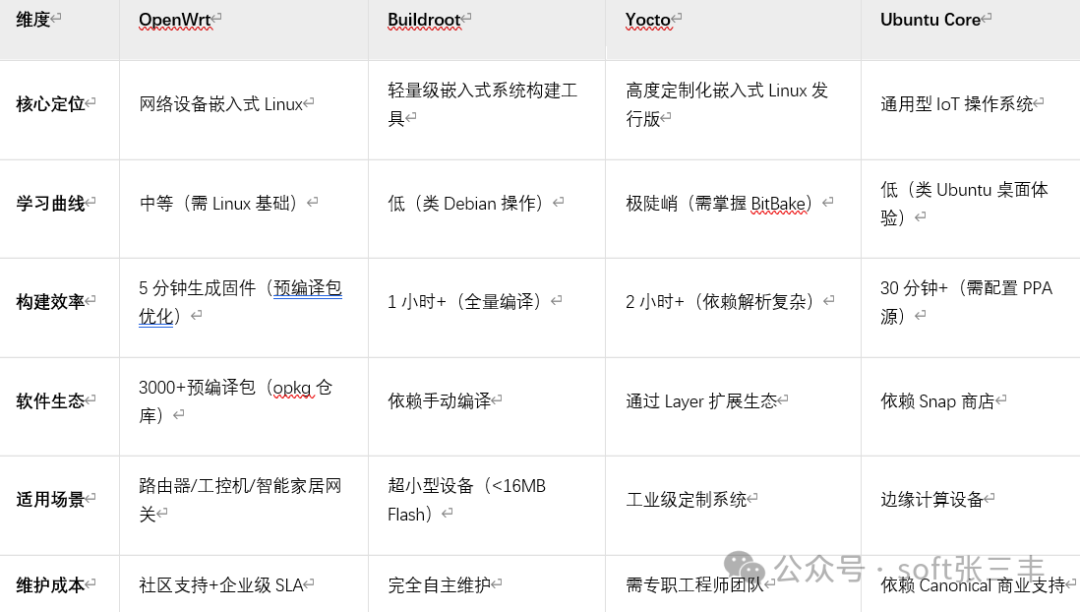Introduction: The Fragmentation Dilemma of Embedded Systems
In fields such as the Internet of Things, smart homes, and industrial control, embedded devices are experiencing exponential growth. However, developers often face two major challenges:
1. Hardware Fragmentation: The coexistence of ARM, MIPS, x86, and other architectures leads to high adaptation costs.
2. Function Customization: From network protocol stacks to security encryption, deep system function trimming is required.
As a Linux distribution specifically designed for embedded devices, OpenWrt has become an industry benchmark due to its cross-platform compatibility and modular design. This article will analyze its core advantages and compare it with mainstream tools (such as Buildroot, Yocto, and Ubuntu Core), revealing its unique competitive strengths.

Five Core Advantages of OpenWrt
1. A ‘Swiss Army Knife’ with Full Platform Coverage
– Architecture Support: Native compatibility with mainstream architectures such as ARM (Raspberry Pi, ESP32), MIPS (Asus routers), x86 (industrial computers), and RISC-V.
– Hardware Abstraction Layer: Dynamic driver loading via `kmod`, allowing the same codebase to adapt to different chip solutions.
2. Modular Software Ecosystem
– 3000+ Software Packages: Covering all scenarios in networking, security, and IoT, from `luci` (Web management interface) to `openvpn` (VPN service).
– OPKG Package Management: Similar to Debian’s APT mechanism, supporting online updates and version rollbacks.
3. Enterprise-Level Networking Features
– Firewall/NAT: Integrated `iptables`, supporting QoS traffic scheduling.
– Wireless Drivers: Perfectly compatible with OpenWrt-specific wireless chips such as `ath9k` and `mt76`.
4. Deep Customization Capabilities
– SDK Development Kit: One-click system trimming via `make menuconfig`, generating minimal firmware (only 2MB).
– Lua Script Extensions: Implementing automated operation and maintenance logic through the `procd` daemon.
5. Community and Commercial Dual-Drive
– Open Source Ecosystem: Over 100,000 stars on GitHub, with contributions from companies like Huawei and Xiaomi.
– Enterprise Cases: Firmware for China Mobile’s optical modems, Asus router systems, and industrial-grade gateway solutions.
Comparative Analysis with Mainstream Tools

Key Conclusions:
– Compared to Buildroot: OpenWrt provides a complete solution, avoiding the pain of compiling from scratch.
– Compared to Yocto: Yocto is suitable for chip manufacturers, while OpenWrt focuses on vertical scenarios for networking devices.
– Compared to Ubuntu Core: Ubuntu Core relies on the Snap ecosystem, while OpenWrt is lighter and more controllable.

Practical Scenarios: How OpenWrt Empowers Industries?
1. Smart Router Development
– Quickly build management interfaces using `luci`, integrating ad filtering (AdGuard Home) and scientific internet access features.
– Example Configuration:
# Enable IPv6 forwarding echo "net.ipv6.conf.all.forwarding=1" >> /etc/sysctl.conf sysctl -p2. Industrial IoT Gateways
– Set up an MQTT server using `mosquitto`, connecting PLCs to cloud platforms.
– Use `cron` to periodically sync data to Alibaba Cloud OSS.
3. Edge Computing Boxes
– Deploy TensorFlow Lite models for local facial recognition.
– Use `frp` for penetrating internal networks and remote device access.
Selection Recommendations: When to Choose OpenWrt?
– Recommended Use:
– When rapid development of networking features (such as VPN, load balancing) is needed.
– When hardware resources are limited (Flash<64MB, RAM<256MB).
– When seeking system transparency and control (to avoid commercial closed-source risks).
– Avoid Using:
– When a complete desktop environment is required (choose Ubuntu Core).
– When the chip manufacturer has not provided an SDK (suggest choosing Yocto).
Conclusion: The ‘Chinese Solution’ of the Open Source Ecosystem
OpenWrt is not just an operating system; it is a milestone for Chinese developers participating in global open source. Its value lies in:
1. Breaking Technical Barriers: Allowing small and medium enterprises to access enterprise-level networking features without payment.
2. Accelerating Product Iteration: Shortening development cycles through community collaboration (average savings of 3-6 months).
3. Security and Control: Transparent source code, avoiding supply chain attack risks.
Open Source Address
Follow the public account and reply 20250503 to obtain
You Might Also Like:
[Open Source] Cross-Platform Reading Tool! BookChatApp Multi-Platform Distribution + Open Source Free, Doubling Development Efficiency!
[Open Source] The Best CRM Tool of 2024, Say Goodbye to High Subscription Fees! In-Depth Review of Chatwoot’s Omnichannel Customer Service Solution
[Open Source] Drag and Run! This Domestic Low-Code Platform Increases Business Process Development Efficiency by 10 Times, Supporting Event-Driven + Stream Programming!
[Open Source] A Beacon of Domestic Development! 10k+ Stars, Apache DolphinScheduler Tops Apache’s Top Projects, Redefining Big Data Scheduling
[Open Source] 3-Second Problem Location! This Java Process Management Tool Doubles Remote Diagnosis Efficiency!
Add WeChat to join relevant discussion groups,
Note “Microservices” to join the group for discussion
Note “Low Code” to join the low code group for discussion
Note “AI” to join the AI big data and data governance group for discussion
Note “Digital” to join the IoT and digital twin group for discussion
Note “Security” to join the security-related group for discussion
Note “Automation” to join the automation operation and maintenance group for discussion
Note “Trial” to apply for product trials
Note “Graduation Project” for collaboration on graduation projects, undergrad 1.2, master 1.5, PhD 1.8
Note “Assistant” to join the code assistant and plugin discussion group
Note “Customization” for project customization, full source code delivery
Software Copyright 148, package materials, package certification, transaction through Taobao guarantee, refund if certification is not obtained, invoices can be issued.
